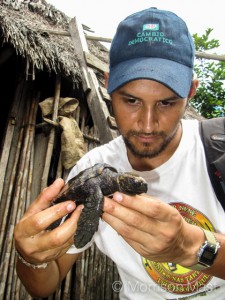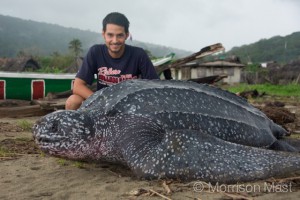
Morrison Mast, 2013-2014, Panama, examines a juvenile hawksbill turtle that washed up nearly dead on the shore; a local fisherman has since nursed it back to good health and re-released it into the wild
“Everybody loves turtles,” my father would say. After he went from being an early-career marine biologist to managing an international wildlife conservation organization (Conservation International), this phrase was an indispensable fixture of his speeches at foundations, scientific symposia, and universities.
This was an almost “universal fact,” he would claim, and it was the basis of the Sea Turtle Flagship Program (now SWOT, a program of the Oceanic Society), an extremely successful initiative founded on the concept that when you invest in the conservation of turtles, a charismatic, universally recognized symbol of peace, you’re also necessarily investing in the conservation of marine wildlife and biodiversity as a whole. By addressing climate change, fisheries regulation, beachfront development, and other threats to sea turtles, you’re addressing the needs of marine ecosystems around the world. After having traveled to dozens of sea turtle conservation projects around the globe, I would never have expected the one place where I’ve found my father’s words to be untrue to be the place where people are most effectively accomplishing “conservation.”
The reason my father’s words don’t apply here in Armila, Panama, is because the Guna Indians’ conception of turtles isn’t necessarily based on positive feelings. During my time as a Fulbrighter working in the indigenous Guna Yala region of Panama, near the border with Colombia, I’ve heard leatherback turtles (Dermochelys coriacea) described in local folklore as being “ugly,” “scary,” “intelligent,” and “vengeful.” For this reason, the residents of Armila, home to one of the world’s densest nesting aggregations of this endangered species, have for a hundred years given these turtles the right of way when it comes to nesting; they don’t remove any eggs or kill any adult turtles, both of which are a source of protein that is heavily exploited around the world.
The research that I have been conducting during my Fulbright on Armila’s beach involves helping conservationists and biologists get a better idea of the abundance and genetic makeup of this nesting rookery: where are these turtles coming from, and how many come to nest in Armila every year? And although scientific research is an indispensable element of any good conservation program, in this isolated last bastion of Guna culture, I saw a need to help this rapidly developing community quickly adapt itself to an inevitable influx of tourism and Western technology.
After spending my first few months as a Fulbrighter learning Dulegaya (the local language) and befriending local policymakers and business owners, I’ve been able to invest some of my grant money into the construction of a community-run guesthouse and information center for tourists. I supported community-led efforts to diversify local community members’ sources of protein to keep turtles off the menu and help them conform to international sea turtle ecotourism best practices. In addition to collaborating with local citizens on my research, I brought in filmmakers and artists over a muddy jungle mountain to tell this town’s story to the world, all the while encouraging the younger generations to take pride in their town and turtles,

Morrison Mast, 2013-2014, Panama, with a leatherback turtle; leatherback turtles can measure over two meters, weigh more than 900 kg, and travel over 11,000 km in one season
None of this would have been possible without getting to know the sprit of the town through countless conversations with local families. No matter how tired I was from walking the beaches counting turtle tracks, I never turned down an invitation from anyone who invited me over for lunch or an over-sweetened coffee in the afternoon. In this 600-person town, there are few people whom I don’t know on a first name basis.
The greatest piece of advice I can give to Fulbright applicants and future grantees is to look at how your work can have a positive impact on the lives of the people you’ll be living with for a year. Work on your elevator pitches. Be able to communicate your research not only to academic peers, but also to the average person in your community, wherever that might be. When people understand why you’re doing what you do, it increases the quantity and quality of the connections you’ll make.
These personal connections have been by far the most rewarding part of my Fulbright experience. I’ve been sharing stories with people, chipping away at cultural boundaries that I didn’t even know could exist. In this place where the words “conservation” and “biodiversity” and so many mainstays of my professional jargon don’t even exist in the local language, I became a part of a gem of a community that, on its own, is doing way more to save sea turtles than any team of trained experts could hope to do.
To learn more about Morrison Mast’s community-based sea turtle conservation program in the indigenous Guna Yala region of Panama, check out his personal blog here.


No Comments